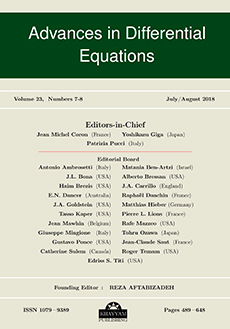Olivier Druet, Emmanuel Hebey
Adv. Differential Equations 7 (12), 1409-1478, (2002) DOI: 10.57262/ade/1356651583
KEYWORDS: 58J37, 35B38, 35B40, 46E35, 53C21
Given $(M,g)$ a smooth compact Riemannian manifold of dimension $n \ge 3$, there exist $A, B > 0$ such that for any $u \in H_1^2(M)$, $$\Vert u\Vert_{2^\star}^2 \le A\Vert\nabla u\Vert_2^2 + B\Vert u\Vert_1^2 , $$ where $H_1^2(M)$ is the standard Sobolev space consisting of functions in $L^2(M)$ whose gradient is also in $L^2(M)$. The best possible $A$ in this inequality is $K_n^2$, where $K_n$ is the sharp constant $K$ in the Euclidean Sobolev inequality $\Vert u\Vert_{2^\star} \le K\Vert\nabla u\Vert_2$. Thanks to previous work by Druet-Hebey-Vaugon and Hebey, it turns out that the above inequality with $A = K_n^2$ is always true when $n = 3$, in other words without any assumption on the manifold, and true when $n = 4$ if the scalar curvature is everywhere negative, or the scalar curvature is nonpositive and the manifold is conformally flat, or the sectional curvature is nonpositive and a local isoperimetric inequality as in the Cartan-Hadamard conjecture holds. On the contrary, thanks to previous works by Druet-Hebey-Vaugon, the inequality with $A = K_n^2$ is false when $n \ge 4$ and the scalar curvature is positive somewhere. Independent considerations give that for any $\varepsilon > 0$ there exists $B_\varepsilon$ such that for any $u\in H_1^2(M)$, $$\Vert u\Vert_{2^\star}^2 \le (K_n^2+\varepsilon)\Vert\nabla u\Vert_2^2 + B_\varepsilon\Vert u\Vert_1^2 . $$ Defining $B_\varepsilon(g)$ as the smallest $B_\varepsilon$ in this inequality, the difficult question we are concerned with in this article is to describe the asymptotic behavior of $B_\varepsilon(g)$ as $\varepsilon\to 0$. A complete answer to this question is given.

